- Author: Kathy Keatley Garvey

Attardo will discuss “The Mating Biology of Tsetse Flies--Insights into the Morphological, Biochemical, and Molecular Responses to Mating Stimuli in a Viviparous Disease Vector.”
"Research into the reproductive behavior of tsetse flies offers key insights into controlling diseases like African sleeping sickness," he writes in his abstract. "Unique among insects, these flies give birth to live offspring. During mating, males transfer a mix of sperm and other vital substances to the females. This study employs state-of-the-art techniques, including 3D scanning and genetic analysis, to monitor changes in the female fly's reproductive system over a 72-hour period post-mating. Findings indicate that mating sets off a chain of intricate changes in the female, affecting everything from biochemistry to gene activity. These changes prepare her for pregnancy and childbirth. The study opens up new avenues for understanding tsetse fly biology and offers potential strategies for disease control."
The seminar also will be on Zoom. The link:
https://ucdavis.zoom.us/j/95882 849672
The Attardo lab monitors the dynamics of vector insects at the levels of physiology, population genetics and environmental interactions.
Attardo is a global expert on vectorborne diseases, including his groundbreaking work on tsetse flies. He researches the invasive yellow mosquito, Aedes aegypti, which can carry such diseases as dengue, chikungunya, Zika and yellow fever. His work involves predicting insecticide resistance and tracking movements of genetically independent populations of aegypti throughout the state.
Attardo, who holds a doctorate in genetics from Michigan State University, where he researched the molecular biology of mosquito reproduction, joined the UC Davis Department of Entomology and Nematology in 2017 from the Yale School of Public Health's Department of Epidemiology of Microbial Diseases.
He received the 2022 Medical, Urban, and Veterinary Entomology Award from the Pacific Branch, Entomological Society of America, which encompasses 11 Western states, plus parts of Canada and Mexico, and U.S. territories.
For any technical issues regarding Zoom, contact seminar coordinator Brian Johnson at brnjohnson@ucdavis.edu.
Resources:
- Tsetse Fly Research (article featuring Geoffrey Attardo, Feb. 3, 2021, UC Davis Department of Entomology and Nematology
- A Tsetse Fly Births One Enormous Milk-Fed Baby, Deep Look, featurng the work of Geoffrey Attardo
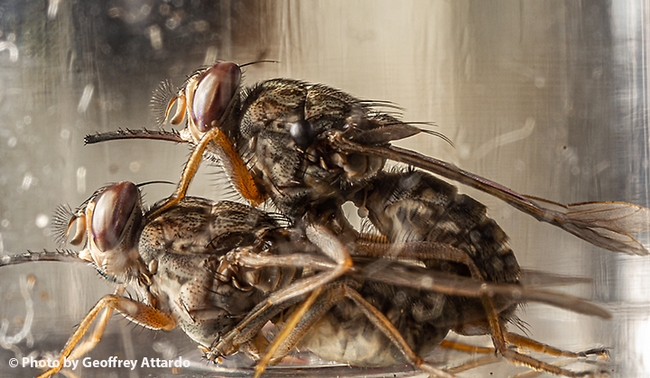
- Author: Kathy Keatley Garvey
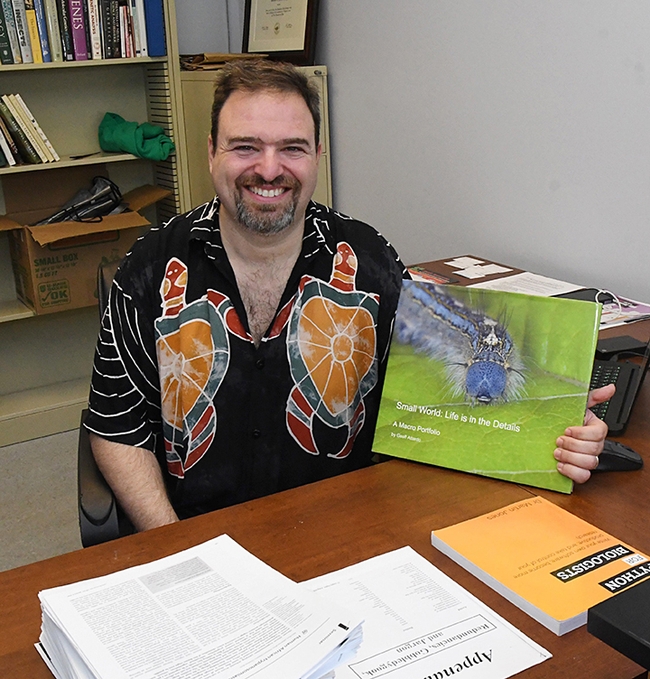
Attardo, who joined the UC Davis Department of Entomology and Nematology in 2017 from the Yale School of Public Health's Department of Epidemiology of Microbial Diseases, “excels not only as a researcher, but as a teacher, mentor, scientific illustrator, macro photographer, videographer and science communicator,” said UC Davis distinguished professor Bruce Hammock in his letter of nomination.
The Attardo lab monitors the dynamics of vector insects at the levels of physiology, population genetics and environmental interactions.
“I have known Geoff personally since July 2017 and I have always admired his scientific expertise, his unbridled enthusiasm, his many talents, and his scores of accomplishments,” wrote Hammock, who holds a joint appointment with the entomology department and the UC Davis Comprehensive Cancer Center. “He leads a highly successful research group that focuses on the molecular biology, biochemistry and physiology of medically important insects. His work, encompassing his research, teaching/mentorship, public service and outreach, brings international recognition to our department, college, university, the UC system and the entomological world.”
Eleven Western States. PBESA will recognize Attardo at an April 12 awards luncheon during its annual meeting, set April 10-13 in the Hyatt Regency Sonoma Wine Country. (link to https://www.entsoc.org/membership/branches/pacific/meeting.) PBESA is comprised of 11 Western states (Alaska, Arizona, California, Hawaii, Idaho, Montana, Nevada, Oregon, Utah, Washington, Wyoming), parts of Canada and Mexico, and seven U. S. territories. (Link to https://www.entsoc.org/membership/branches/pacific)

Attardo received a Ruth Kirshstein National Research Service Award from the National Institutes of Health (NIH) to study the molecular and biochemical physiology of tsetse fly lactation. His results “broadened our understanding of the physiology of live birth and lactation,” said Hammock, adding that his work “was the first to bring to bear state-of-the-art/high-throughput genetic, molecular and biochemical techniques.”
The co-principal investigator of a five-year NIH R01 grant, Attardo led a multinational collaboration resulting in the production, annotation and functional analysis of the first tsetse fly genome sequence.
Attardo is also a talented macro photographer and scientific illustrator, Hammock noted. Science editors featured his tsetse photo on their cover and used his illustrations throughout the article to show the tsetse's unique physiology. Attardo's work also drew high-profile coverage twice in the New York Times.
Attardo's current work focuses on defining the mating physiology of tsetse flies. He uses X-ray based MicroCT scanning to generate high resolution 3-dimensional images of tsetse reproductive tissues to understand the morphological specializations that enable live birth and lactation in tsetse flies. (See Attardo lab)
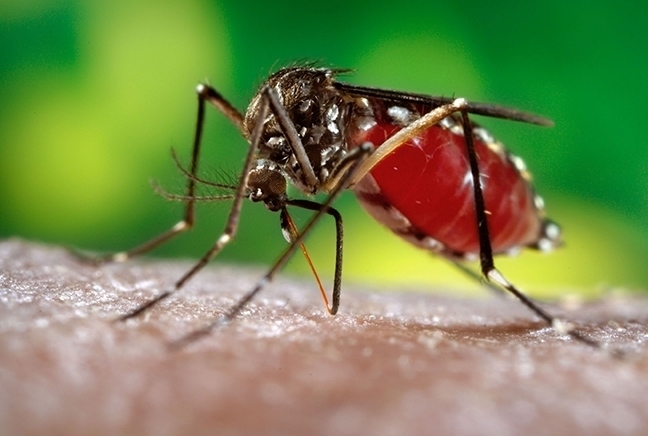
Attardo collaborated with the KQED (Public Broadcasting Service) “Deep Look” team to produce a YouTube video featuring macro footage and illustrations of tsetse live birth, blood feeding, and mating. The video, winner of a 2020 Northern California Emmy Award, has scored 6.2 million views, as of Jan. 4, 2022.
In a letter of support, molecular geneticist and physiologist Joanna Chiu, vice chair of the UC Davis Department of Entomology and Nematology, wrote in part:
“Dr. Attardo's internationally recognized research program on the physiology and genomics of insect vectors is creative, significant, and always of the highest quality and rigor. His research program seamlessly integrates fundamental mechanistic work and applied research to study physiology and behavior of insects that vector devastating human diseases. His teaching and mentoring program is innovative, inclusive, and he is fiercely supportive of his trainees and junior colleagues. Finally, he is passionate about outreach and extension because he understands the importance and value of transferring technologies from his lab to the field and extending information to benefit stakeholders locally and internationally.”
Very Effective Teaching Style. For the past two years, Chiu and Attardo have been co-teaching an undergraduate animal biology course on “Applications, Social and Ethical Issues in Animal Biology.” Chiu praised his ability to “engage the students” and his “very effective teaching style in helping students build critical thinking skills and confidence.”
Professor Immo Hansen of the Department of Biology, Institute of Applied Biosciences at New Mexico State University, echoed the praise. “Geoff is a prolific scholar with more than 55 publications and an h-index of 30 a value that one might expect for a full professor in the entomology field (my own h-index is 29). His early work on mosquito regulation of gene expression and nutritional signaling pathways as well as his later works on Tsetse genomics, nutrition, milk production, and symbiont interactions are highly original and represent significant increases in our knowledge in insect reproductive physiology.”
“He led the effort to sequence and annotate the genome of the Tsetse fly which resulted in a Science paper,” Hansen pointed out. “Geoff is a leading expert in the field of the molecular basis of insect reproduction (of tsetse flies) which is reflected by the large number of invited presentations he has given over the years. His truly innovative research in the field puts him at the forefront of researchers in his discipline.”
- Author: Kathy Keatley Garvey

Host is medical entomologist/geneticist Geoffrey Attardo, assistant professor, UC Davis Department of Entomology and Nematology. The Zoom link is here.
"Tsetse flies house an assortment of endosymbiotic bacteria and serve as the prominent vectors of pathogenic African trypanosomes," Weiss says in his abstract. "Tsetse and insect stage trypanosomes are metabolically dependent on the fly's endosymbiotic bacteria in order to maintain their physiological homeostasis. I will describe these interdependencies and
how they can be exploited to decrease tsetse's vector competency."
Weiss received his master's degree from the University of Queensland, Brisbane, in 1997 and his doctorate from the University of Alberta, Canada (2003).
"My research focuses on acquiring a better understanding of the relationship between insect disease vectors and their associated micro-organisms," he writes on his website. "To this end, I currently use the tsetse fly (Glossina morsitans morsitans) as a model system. These insects are the sole vectors of pathogenic African trypanosomes, which are the causative agent of Human African trypanosomiasis. Tsetse flies also harbor indigenous endosymbiotic bacteria that are intimately associated with their host's physiological well-being. I am interested in learning more about (1) the evolution adaptations that permit host tolerance of bacterial endosymbionts, (2) how symbiotic bacteria impact host physiology, with specific emphasis on nutritional supplementation and host immunity, and (3) how to use microbial symbionts to reduce disease vector competence."
Cooperative Extension specialist Ian Grettenberger coordinates the winter seminars. For technical issues, contact him at imgrettenberger@ucdavis.edu.
- Author: Kathy Keatley Garvey
(Editor's Note: Geoffrey Attardo, assistant professor, UC Davis Department of Entomology and Nematology, published this piece July 29, 2020 on The Conversation website. This article is republished from The Conversation under a Creative Commons license. Read the original article.)
Bloodthirsty tsetse flies nurse their young, one live birth at a time – understanding this unusual strategy could help fight the disease they spread
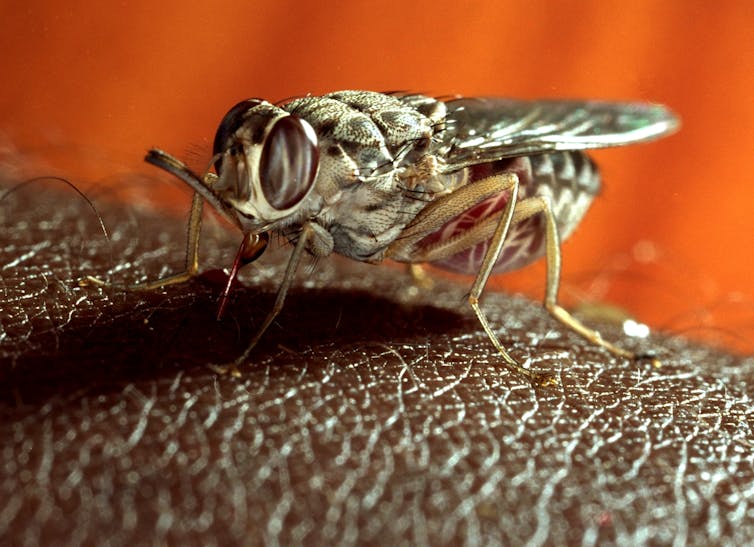
By Geoff Attardo, University of California, Davis
Tsetse flies are bloodthirsty. Natives of sub-Saharan Africa, tsetse flies can transmit the microbe Trypanosoma when they take a blood meal. That's the protozoan that causes African sleeping sickness in people; without treatment, it's fatal, and millions of people are at risk due to the bite of a tsetse fly.
My entomology research focuses on insects that feed on the blood of people and animals. From a human health standpoint, understanding what makes all these bugs tick is key to developing ways to control them and prevent transmission of the diseases they carry, such as malaria, dengue, Lyme disease, West Nile virus and many others.
Tsetse flies stand out from their blood-feeding cousins the mosquitoes and ticks because of their unique reproductive biology. They give birth to live young and, even more unusual, the mother lactates and provides milk for her offspring. Here's how it all works – and why their unusual reproduction strategy might be a key to controlling tsetse flies and the parasite they carry once and for all.
From egg to larva
Scientists know of other flies that hold onto their eggs in their reproductive tract until they hatch into young larvae, with each brood consisting of dozens of offspring. The mother then tries to find a suitable source of nutrition in the environment, deposits the larvae and leaves them to survive on their own. The mother does not provide any nutrition for her young.
That's the standard fly way of life. Tsetse flies take a different approach.
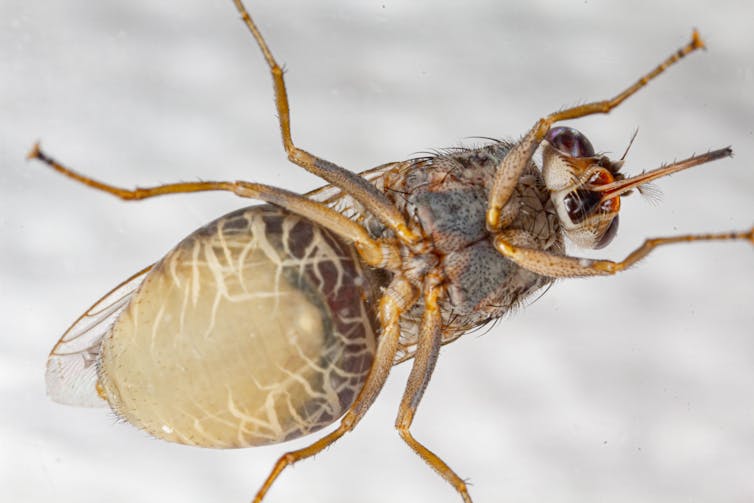
Female tsetse flies develop just one single egg at a time. When the egg is complete, the mother moves it from her ovaries into her uterus in a process called ovulation. Once in the uterus, the egg is fertilized with sperm the female has stored in an organ called the spermatheca. While females can mate multiple times, they obtain all the sperm they need for their lifetime from a male fly during a single mating event.
After fertilization, the female keeps the egg in her uterus for five days while an embryo develops within the egg. When the embryo is ready, the egg hatches in the uterus of the female and the tsetse fly larva begins its life living inside its mother's uterus.
Milk meals for baby
Here's where tsetse flies dramatically diverge from most other insects.
Attached to the mother's uterus is a specialized gland that makes a milk-like substance. The organ is called the milk gland, and it produces a rich mixture of fats and particular proteins that provide the larva with all the nutrition it needs to develop into an adult.
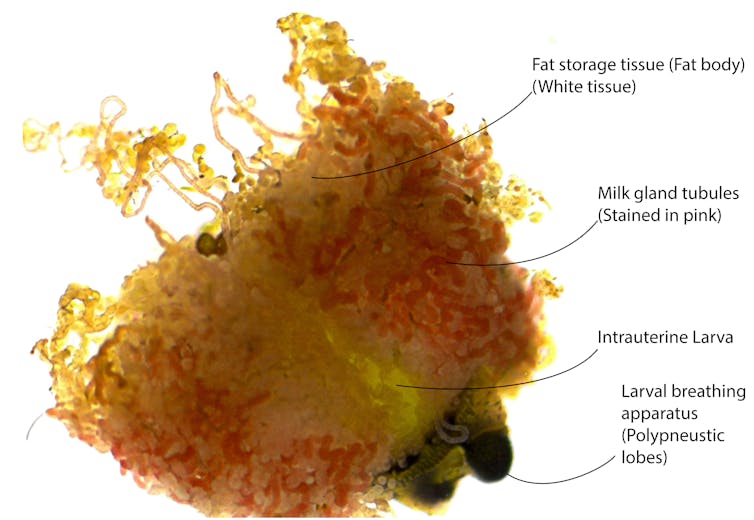
Amazingly, many tsetse milk proteins are very similar in function to those found in the milk produced by mammals.
Just like in mammals, the milk also transfers beneficial bacteria from the mother to the offspring. These bacteria are essential for tsetse flies, and without them adult female flies are unable to reproduce.
After five or six days of developing and feeding on milk, the larva is fully grown and ready to enter the world. The mother finds a safe spot and gives birth. The larva immediately burrows underground to avoid predators and parasites.
Once buried, the outer surface of the larva's skin hardens and turns black, forming a protective shell. This is called the pupal stage and it lasts for around three weeks. During this time, the pupa transforms into an adult fly.
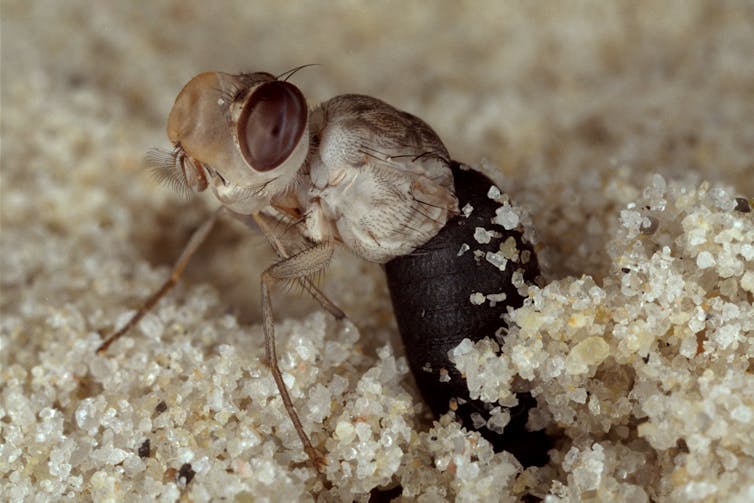
It then emerges from the pupa, climbs out of the ground, and begins its life as an adult tsetse fly looking for hosts to blood-feed on and other tsetse flies to mate with.
Why live birth?
Why would an insect evolve this slow and resource-intensive way to reproduce?
One idea is that this method provides a defensive advantage relative to free-living larvae against parasites and predation. Larvae on their own have few (if any) ways to defend against these threats. But keeping larvae in the mother's uterus provides shelter and a guaranteed food source. While this strategy is much slower, scientists think the extra maternal care results in higher larval survival rates. It's a matter of quality over quantity.
A result of this reproductive strategy is that tsetse fly populations are small and slow to recover from control efforts, relative to more prolific insects like mosquitoes.
My colleagues and I hope that we can parlay our understanding of the molecular processes that regulate tsetses' milk production and mating behavior into new environmentally friendly, cost-effective and tsetse-specific control strategies for these insects.
The sleeping sickness tsetse flies spread is a potential issue for millions of people in 36 sub-Saharan countries, though the number of annual cases has decreased drastically thanks to major control efforts – including trapping flies, applying insecticides and releasing sterile males to the environment where they mate with wild females but don't produce offspring. Ultimately, we'd like to contribute to the World Health Organization's goal of eliminating African sleeping sickness by 2030 with a new way to prevent the transmission of disease-causing trypanosomes to people and animals.![]()
- Author: Kathy Keatley Garvey
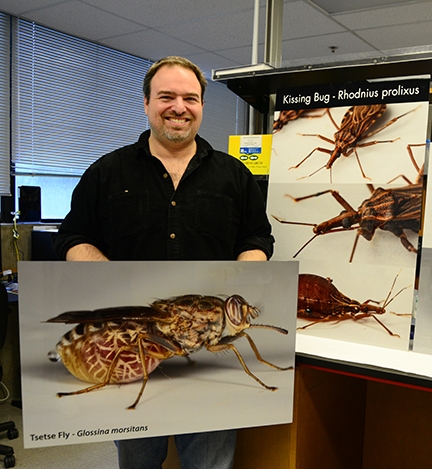
The event is free and open to the public and will be hosted by Jared Shaw of the UC Davis College of Letters and Science.
“It is actually going to be a very basic talk aimed at lay audiences and kids,” Attardo says. “I'll be talking about my background, how I became an entomologist and how I ended up working on tsetse flies. Then I am going to discuss the life history of tsetse flies, where they can be found, why they are of medical importance and how their reproductive biology differs so dramatically from other flies that people are familiar with. My plan is to go over their reproductive cycle, how they develop intrauterine larvae, the reproductive adaptations that allow them to perform this feat and then go over what we know about tsetse milk secretions and how they compare to mammalian milk in terms of nutritional content.”
“The aim is for it to be very informal, with very little scientific jargon and to be discussion-oriented so that there is lots of questions and answers. I am also bringing some items from the lab that can be passed around the audience for show and tell (homemade tsetse cages, the blood feeding system we use to feed the flies and some tsetse flies preserved in alcohol).
Attardo focuses his research on numerous aspects of the physiology of tsetse fly reproduction, with the goal to identify and understand key aspects of its reproductive biology. He joined the UC Davis Department of Entomology and Nematology in 2017 from the Yale University School of Public Health, New Haven, Conn., where he researched tsetse flies in the lab of Serap Aksoy.
Attardo considers the tsetse fly "one of the champions of the insect world."
"In addition to being vectors of a deadly disease, Trypanosomiasis, these flies have undergone amazing alterations to their physiology relative to other insects," he says. "Some examples of this are their ability feed exclusively on blood, their obligate relationship with a bacterial symbiont, the fact that they lactate and that they give birth to fully developed larval offspring."
Attardo is the co-author of Adenotrophic Viviparity in Tsetse Flies: Potential for Population Control and as an Insect Model for Lactation, published in January 2015 in the Annual Review of Entomology.


